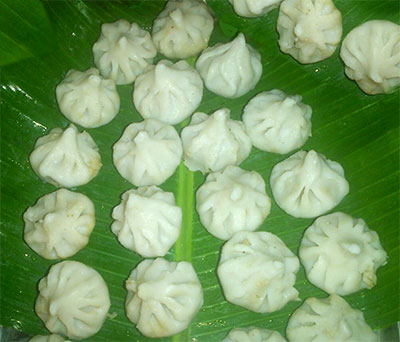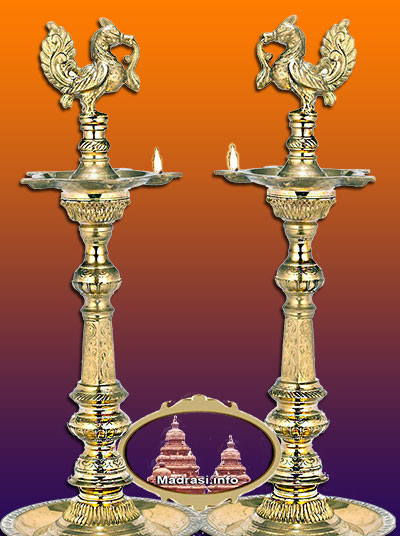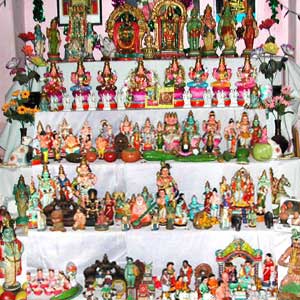| Chennai India | Transport | Chennai Real Estate | Home Issues | Education | Destination | Recreation | Chennai Hotels | Cars in India |
|
Home Issues
Pongal
December Festival
Henna Hair Dye
Home Flooring
Chennai Furniture
Home Furnishing
Ayurveda Treatment
Rainwater Harvesting
Navarathri Festival
Dengue Fever
Chickungunya
Summer Sunscreen
Heat Rash
Kanjivaram Silk Sari
Madras Filter Coffee
Vastu Shastra
Vastu Tips
Air conditioning Tips
|
Significance of NavarathriNavrathri is celebrated all over Tamil Nadu for nine days during the Tamil month Purattasi (September-October). It is a celebration of the victory of Goddess Durga or Parashakthi over the demon king Mahishasura. On the tenth day Vijaya Dhasami, the day of victory is observed with all religious fervor. Symbolically it is said to be the victory of good over evil. Vijaya Dashami or Dasara or Dussehra marks the end of the Navarathri festival. This day is considered auspicious and holds significance for those embarking on a new business, education or venture. It marks the day when Rama won the battle with Ravana. This day marks the Triumph of Good over Evil. Various anecdotes of Rama's life are enacted throughout the nine days in different places in North India. Effigies of Ravana are burnt on public grounds on this final day. Vijayadasami is celebrated all over the country. In Bengal, the idols of Goddess Durga are immersed in the waters after 9 days of festivities and prayer. Mysore has a rich tradition of celebrating Dasara with royal pomp and splendor - actually presided over by the MahaRaja of Mysore. Religious significance of Navarathri According to Devi Mahathmiyam (from Markandeya Purana), Parasakthi is the embodiment of Icha Sakthi, Kriya Sakthi and Gnana Sakthi and is the better half of the Supreme God , and She takes various forms as Parvathi, Lakshmi, Saraswathi and Durga in different Avatars. The Avatar of Parasakthi, according to Hindu mythology is described like this: When the Devas were troubled by the Asuras, they took it to the Lords - Siva, Vishnu and Brahma. The anger of gods against the Asuras took the form of a bright light which spread all over the universe and later appeared in the form of a woman who shone brilliantly. While Lord Siva created a Thrishul out of his own, Mahavishnu created a wheel out of his Chakrayudh and all the Devas followed suit by giving armour to Devi. Devi Parasakthi, armoured and bedecked with beautiful ornaments fought with the demons, destroyed the evil and regained peace. In Tamilnadu, the victory of Goddess Durga is celebrated for nine days. The festival is called Sharada Navarathri. In the month of Purattasi, after the Mahalaya Amavasya, starting from the first day of the lunar month, till the Vijayadasami day the state takes a festive look, with many homes displaying beautiful dolls of Gods and Goddesses, in steps or tiers. This festival is also called 'Kolu' which means the Ambal or Ambigai. In a symbolic way of worship, besides the daily pujas, and special Aarthis, women folk (Sumangalis) of the neighbourhood are invited to these houses and offered Thamboolam ( betel leaves, flowers and vermilion) Young girl children are also given a warm welcome as many consider them as a form of Devi Herself. Shlokas that are recited during Navaratri include Durga Ashtotaram, Devi Mahatmiyam, Shyamala Dhandakam, Lakshmi Sahasranama, Lakshmi Ashototaram, Lalitha Sahasranamam, Saraswathi Stotram and Saraswathi Ashototaram. A lamp is kept continuously lit during this period. Many people observe a fast on some or all days. Some don't eat anything save milk and fruits, some eat just one meal a day while some others remain vegetarian during this period. Kanya Puja or Kumari Puja is an important aspect of the puja during navaratri. Young girls are considered embodiments of unmanifested energy and they are intrinsic to this puja. Kolu or Display of Dolls Depending on the space and number of dolls, one can even erect eleven steps. A variety of dolls depicting mythological themes from epics and scriptures are displayed. The tiers are decorated beautifully with festoons. The most popular themes are Dhasavathar – the ten incarnations of Mahavishnu, Ashta Lakshmi- eight avatars of Mahalakshmi, Rajarajeswari Dharbar and Krshna Leela. Lasting for nine days, the evenings conclude with arti, prayers and prasadham like sundals and sweets. Ninth day of Navrathri is celebrated as Saraswati puja, dedicated to Goddess Saraswati, the Goddess of learning. Musical instruments, books and other instruments are also placed and decorated before the Kolu and worshiped with flowers. The last day of the festival known as Vijaya Dasami is considered to be auspicious to start any new venture in learning dance, music and fine arts. According to tradition, a marapachi or any human figure among the dolls is put to sleep on the tenth night symbolically denoting the defeat and death of the demon in the battle with Parasakthi. The dolls are packed carefully, the next day with paper or cloths and kept in a box. Navrathri is a festival celebrated with enthusiasm and it provides an opportunity to meet friends and promote goodwill. More tradition-bound people celebrate Navrathri with Pujas and homams to propitiate Goddess Durga. In temples, Goddess Durga is decorated as different incarnations of Paraskthi on each day. According to Vedic scholars there are some spiritual connotations; the first three days of Navrathri being dedicated to Durga to breed courage and valour in the minds of people. The next three days are devoted to worshipping Lakshmi to bring prosperity and the last three days are spent in the worship of Saraswati, the promoter of learning. comments powered by Disqus |




|
|
|
||